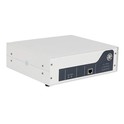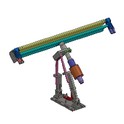In the realm of industrial and scientific applications, ultrasonic technology has emerged as a powerful tool with a wide range of uses. As a trusted supplier of 500W ultrasonic generators, I am often asked about the various equipment that can be combined with these generators to enhance their functionality and expand their application scope. In this blog post, I will delve into some of the key equipment that can be paired with a 500W ultrasonic generator, exploring the benefits and potential applications of these combinations.
Ultrasonic Transducers
One of the most fundamental components that work in tandem with an ultrasonic generator is the ultrasonic transducer. Transducers are responsible for converting electrical energy from the generator into mechanical vibrations at ultrasonic frequencies. When selecting a transducer to pair with a 500W ultrasonic generator, it is crucial to consider factors such as frequency, power handling capacity, and the specific application requirements.
For instance, in ultrasonic cleaning applications, a high - frequency transducer (e.g., 40 kHz) can be used to generate fine cavitation bubbles that are effective in removing small particles and contaminants from the surface of objects. On the other hand, lower - frequency transducers (e.g., 20 kHz) are more suitable for applications where deeper penetration and more powerful cavitation are required, such as in ultrasonic welding or sonochemistry.
The combination of a 500W ultrasonic generator and a well - matched transducer can significantly improve the efficiency and performance of ultrasonic systems. The generator provides the necessary electrical power and control signals, while the transducer converts this energy into the ultrasonic vibrations needed for the specific task.
Ultrasonic Horns
Ultrasonic horns, also known as sonotrodes, are another essential piece of equipment that can be combined with a 500W ultrasonic generator. Horns are used to amplify and focus the ultrasonic vibrations generated by the transducer. They come in various shapes and sizes, each designed for a specific application.
In ultrasonic welding applications, for example, a custom - designed horn can be used to deliver the ultrasonic energy precisely to the welding area, ensuring a strong and reliable bond between the materials. In ultrasonic cutting, the horn is shaped to provide a sharp cutting edge, allowing for clean and accurate cuts in materials such as plastics, rubber, and food products.
The 500W ultrasonic generator powers the horn through the transducer, enabling it to generate the high - amplitude vibrations required for these applications. By carefully selecting the appropriate horn design and material, the performance of the ultrasonic system can be optimized for maximum effectiveness.
Ultrasonic Cleaning Tanks
When it comes to ultrasonic cleaning, a 500W ultrasonic generator can be paired with an ultrasonic cleaning tank. The cleaning tank is filled with a cleaning solution, and the ultrasonic vibrations from the transducer and horn create cavitation bubbles in the solution. These bubbles implode near the surface of the object being cleaned, dislodging dirt, grease, and other contaminants.
The size and design of the cleaning tank are important considerations. A larger tank can accommodate more objects, but it may require a more powerful generator to ensure uniform cleaning throughout the tank. The 500W generator is suitable for small - to - medium - sized cleaning tanks, making it ideal for applications in laboratories, jewelry shops, and small - scale industrial cleaning operations.
The combination of a 500W ultrasonic generator and a well - designed cleaning tank provides an efficient and cost - effective solution for removing contaminants from a variety of objects, including precision parts, electronic components, and jewelry.
Ultrasonic Reactors
In the field of sonochemistry, a 500W ultrasonic generator can be combined with an ultrasonic reactor. Ultrasonic reactors are vessels designed to carry out chemical reactions under the influence of ultrasonic waves. The ultrasonic vibrations can enhance mass transfer, increase reaction rates, and even enable reactions that are difficult or impossible to achieve under normal conditions.
The 500W generator provides the necessary power to generate ultrasonic waves within the reactor. The reactor can be equipped with various features such as temperature control, stirring mechanisms, and sampling ports to optimize the reaction conditions. This combination is particularly useful in research laboratories and small - scale chemical production facilities for developing new chemical processes and synthesizing novel materials.
Ultrasonic Flow Cells
For applications in the food and beverage industry, pharmaceuticals, and water treatment, a 500W ultrasonic generator can be paired with an ultrasonic flow cell. Ultrasonic flow cells are designed to treat fluids as they flow through the cell. The ultrasonic vibrations can be used for various purposes, such as emulsification, homogenization, and microbial inactivation.
In emulsification, the ultrasonic waves break down large droplets of one liquid phase into smaller droplets, creating a stable emulsion. In homogenization, the vibrations ensure a uniform distribution of particles in a fluid. And in microbial inactivation, the cavitation bubbles generated by the ultrasonic waves can disrupt the cell walls of microorganisms, reducing their viability.


The 500W generator powers the ultrasonic transducer in the flow cell, allowing for continuous and efficient treatment of fluids. This combination is an effective solution for improving the quality and stability of products in these industries.
Other High - Power Ultrasonic Generators for Comparison
If your application requires more power than a 500W ultrasonic generator can provide, we also offer higher - power options. For example, our 3000W Ultrasonic Generator is suitable for large - scale industrial applications such as heavy - duty cleaning, large - volume sonochemistry, and high - power ultrasonic welding. Our 6000W Ultrasonic Generator offers even greater power for the most demanding applications. And if you need a power level between 500W and 3000W, our 2000W Ultrasonic Generator might be the perfect choice.
Conclusion
The 500W ultrasonic generator is a versatile and powerful tool that can be combined with a variety of equipment to meet different application needs. Whether it is ultrasonic cleaning, welding, sonochemistry, or fluid treatment, the right combination of a 500W generator with transducers, horns, tanks, reactors, or flow cells can provide efficient and effective solutions.
If you are interested in exploring the potential of our 500W ultrasonic generators or other related products, and you have specific requirements for your application, I encourage you to reach out to us for a detailed discussion. Our team of experts is ready to assist you in selecting the most suitable equipment and providing you with comprehensive technical support. We look forward to the opportunity to work with you and help you achieve your goals in the field of ultrasonic technology.
References
- Mason, T. J., & Lorimer, J. P. (2002). Applied Sonochemistry: The Uses of Power Ultrasound in Chemistry and Processing. Wiley.
- Suslick, K. S. (1990). Sonochemistry. Science, 247(4941), 1439 - 1445.
- Povey, M. J. W. (1997). Ultrasonics in the Food Industry. CRC Press.






